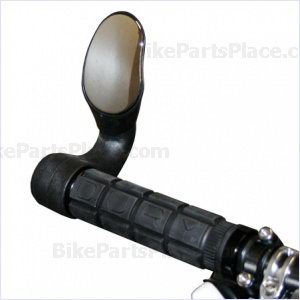
- Mirrors can help you stay aware of your surroundings
- Mirrors can be mounted on glasses, helmets or handlebars
- Make sure whichever mirror you choose works with your equipment
As more and more people turn to bicycles for transportation and recreation, it’s becoming increasingly important for cyclists to be aware of their surroundings at all times.
Whether its cars on the street or others exercising on a busy recreation path, bike mirrors can help you keep an eye on things while you’re on the bike.
While all bike mirrors do the same thing – give you a view of what’s coming from behind – they go about it in different ways. There are four basic mounting styles of mirrors – glasses, helmet, bar end and clamp end.
Mirrors for glasses mount on the left (or right) bow and stick out in front of the lens. The mirror is easily interchangeable with multiple pairs of glasses. With just a quick glance to the side, without moving your head, you’ll get a good view of the road behind you. The mirror itself is about the size of a postage stamp.
Depending upon what kind of glasses or sunglasses you have, this kind of mirror might not work. Though the mirror bracket is typically very adjustable, it can’t accommodate everything, so be sure to try it before you walk out of the store with it.
Similar to the glasses mount is the helmet-mount mirror. Often held in place by a small pad of adhesive, the helmet mirror also sticks out ahead of the rider and is about the size of a postage stamp.
If you have a very vented pro-style helmet (the Giro Ionos, for example), there may not be room to place the adhesive pad. Be sure to bring your helmet with you to the store if you’re considering this type of mirror. Also, if you tend to toss your helmet into a basket or into the backseat after a ride, keep in mind that could break the mirror or bracket.
There are a number of different choices for mounting a mirror onto a bar end. There are road bike- and mountain bike-specific mirrors to account for the differences in bar shapes.
One mirror, called the Italian Road Bike Mirror, installs like a bar-end plug on the left side of a road bike handlebar. The result is a mirror that doesn’t stick out to the side at all. The downside is having to look down to see what’s behind you.
A different mirror, one that has an arm and a round, flat mirror, will also work on road bikes. It, too, installs into the bar-end plug, and is very adjustable in order to get the best view to the rear. The same type will also work on most mountain and hybrid bikes, with just a bit of adjustment to the arm.
A clamp-on mirror performs similarly to the plug-and-arm-style mirror, but installation will likely require repositioning of the grip, shifter and brake levers. If such an installation is beyond your skills, it will likely cost between $10 and $20 at a bike shop.
Whichever mirror you choose, be sure you’re comfortable with its use and the perspective it gives of the road behind.
Tags: bike mirrors


 Shopping
Shopping



I have tried the helmet mirrors, and for me they were a distraction. I don’t know if it’s because I wasn’t used to them, or because I was raised on looking at the handle bars for the mirror. It’ just an ingrained reaction to look down, even when I’m driving a car. I always check my side mirrors, so the bar mirrors would be my choice. Just my opinion.
I honestly like the old round mirrors I used to have. I even tries some rectangular ones, but they added too much weight. I use my mirrors on my truck a lot, so I’m used to it. I feel better when I can glance down and get a quick survey. I haven’t had much luck with helmet mirrors. I feel like my eyes are swaying too far from the road ahead.